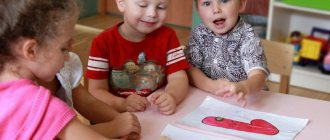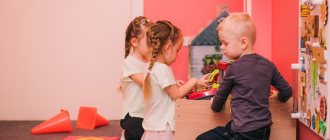Following the Concept of modernization of Russian education, the main guidelines for the formation of value orientations of children and their development in the current socio-cultural conditions have been identified, which are that “A developing society needs modernly educated, spiritually moral, enterprising people who can independently make responsible decisions in a situation of choice, predicting their possible consequences; capable of cooperation, characterized by dynamism, constructiveness, with a developed sense of responsibility, physically and mentally healthy.”
Based on these requirements, the model of a preschool educational institution graduate is as follows: having a high level of cognitive development, possessing creative thinking, with high performance in all mental processes.
Cognitive activity is the child’s active activity in acquiring and using knowledge.
In the process of cognitive activity, the child’s cognitive development occurs, that is, the development of his cognitive sphere (cognitive processes): visual and logical thinking, voluntary attention, perception, memory, creative imagination.
Cognitive activity, being one of the types of activity, includes a goal, motive, methods, conditions, and result.
Cognitive activity is always based on a problem, so its goal is determined by solving the difficulties that have arisen.
The main task of a child’s cognitive development is the formation of the need and ability to think actively and overcome difficulties in solving various mental problems.
To carry out full-fledged education and upbringing of preschoolers, it is necessary to develop cognitive processes - intuition, abstraction, thinking, the ability to solve cognitive problems, and the accumulation of sensory experience. The development of a child’s mental abilities is the most important task of his comprehensive development. The main method of development of a preschooler is problem-based - search, and the main form of its organization is play. The form of work for children is more important than its content. Development of children's cognitive abilities"
A child by nature is a researcher; he is constantly involved in research. This is his natural state: communicate with people, studying their behavior, tearing paper and seeing what happened, watching fish in an aquarium, talking with a dog or cat, disassembling toys, studying their structure. Without these “frivolous” activities, the development of curiosity, which later turns into a cognitive need, is impossible. It is more interesting and easier for a child to explore the world in the position of a researcher than to obediently swallow portions of ready-made knowledge.
There is nothing more harmonious than a child playing. The power of this harmony is so great that adults watching a child’s play involuntarily smile, experiencing joy and delight. The role of adults in this process is to help organize children's research, make it useful and safe for the little researcher and his environment. The whole life of a preschool child is permeated with play; this is the only way he is ready to open himself to the world and the world for himself. Learning and play are absolutely compatible processes in preschool childhood. The game always teaches! And with skillful pedagogical leadership and thoughtful organization, it teaches perfectly! To carry out full-fledged education and upbringing of preschoolers, the development of cognitive processes is necessary.
When choosing educational games for your child, remember that the most important factor in the development of cognitive abilities of preschoolers is the example of adults. It's no secret that children learn something new by imitating their elders. Moreover, this applies to both positive aspects and negative examples. So wouldn't it be better if the child had more positive role models in front of his eyes?
For example, a child can learn the names of cutlery, but his parents must show him how to eat soup from a plate with a spoon. The same standards for the perception of form are geometric figures, for the perception of color - the spectral range of colors, etc.
Memory is a complex cognitive process through which a person can remember, retain and reproduce his past experiences. The development of cognitive abilities of preschoolers has the opposite property - exceptional photographic ability. Children can easily memorize any poem or fairy tale. If an adult, while retelling a fairy tale, deviates from the original text, the child will immediately correct him and remind him of the missing detail. But already at the age of 5–6 years, voluntary memory begins to form. Along with visual and figurative memory, verbal and logical memory arises and develops in the preschool period. The task of adults is to accelerate the development of these types of memory in children.
The development of memory in preschool children is facilitated by learning poetry, telling listened fairy tales, poems, and observing during walks. Poems are chosen with a plot character. An adult must ask questions of a child.
You should read and retell as many Russian folk tales as possible: “The Pockmarked Hen”, “Kolobok”, “Teremok”, “The Little Goats and the Wolf”, “Turnip”, “The Cockerel and the Bean Seed”, “Masha and the Bear”, “The Chanterelle” with a rolling pin”, “Zhikharka”, “Resin Barrel”, etc. You need to read the fairy tale more than once. When reading and learning poems by Russian writers about nature with your child, it is necessary to introduce the child to the seasons. The child must understand well that winter is always replaced by spring, spring by summer, summer by autumn, and autumn by winter. It is imperative to talk with your child about what happens in nature in winter (poems by Drozhzhin, Pushkin), spring (poems by Fet, Pleshcheev), summer and autumn (poems by Maykov). You can also memorize excerpts from K. Chukovsky’s poems “Telephone”, “Stolen Sun”, “Moidodyr”; A. Pushkin “There is a green oak near the Lukomorye”, S. Mikhalkov “What do you have?”, S. Marshak
“Fire”, “Baggage”, V. Mayakovsky “What is good and what is bad?” etc. Be sure to read and try to remember excerpts from K. Chukovsky’s works “Aibolit”, “Fedorino’s Mountain”, “Cockroach”, “Confusion”. For retelling, you can use the stories of E. Charushin. In the future, using elements of the structure of a fairy tale, you can try to compose your own fairy tale with your child
Attention is a form of organization of cognitive activity. The level of a child’s academic performance and the productivity of educational activities largely depend on the degree of formation of such a cognitive process as attention. Psychologists believe that the emergence and development of voluntary attention is preceded by the formation of regulated perception and active proficiency in speech. The better the speech of a preschool child, the higher the level of development of perception, the earlier voluntary attention is formed. In order for a preschooler to learn to voluntarily control his attention, he must be asked to think out loud more.
Since game motivation in cognitive activity is leading throughout preschool age, a game form of cognitive classes is carried out and the active use of game techniques during the lesson is carried out.
Organizational structure of a gaming cognitive lesson.
In the introductory part, a cognitive task is set for children or a cognitive-game problem situation is created that provokes the setting of a cognitive task.
The main part involves solving the problem.
In the final part, children analyze the results obtained, the course of cognitive activity, methods of implementation, focusing on the effectiveness of solving a cognitive-game situation.
Lego constructors provide great opportunities for a child’s cognitive activity.
“Dienesh Logic Blocks” are also an effective developmental tool.
H. Kusener's colored sticks are actively used in the educational process. From a mathematical point of view, sticks are a set on which relationships are easily discovered. You can use didactic games developed by Z. A. Mikhailova, L. V. Artyomova, L. A. Wenger, B. N. Nikitin.
To include a child in a problem-game situation in the classroom, you can actively use modeling.
To eliminate a problem, action is required to investigate everything that is associated with a given problem situation.
Working with children within the framework of joint cognitive activity excludes specially organized classes. The activity of children is caused by the teacher, who involves them in cognitive and play activities, demonstrating his own passion for it.
It is necessary to build joint cognitive activity so that the child, if desired, can continue it independently until he exhausts his interest.
As an object of knowledge, we can take examples from nature; as an emotional component - drawings, photographs, pictures, short figurative entertaining sketches addressed to the feelings of the child, folk riddles (poetic image, riddles invented by children according to certain rules (their own artistic image).
Each child is unique and will not be repeated. The teacher's task is to help the child discover
talents. Every child should go home victorious. Success is the most
the best teacher, as he gives the child confidence in his abilities and
to yourself. A child is born for success!
Preschoolers with developed intelligence remember material faster, adapt more easily to a new environment, and are better prepared for school.
Application
Games for developing perception.
Game “KNOW THE OBJECT”
The proposed game teaches how to compare objects with each other and is intended to develop perception in children aged 4-6 years. To play the game, you need to put various small objects in a linen bag: different buttons
quantities, thimble, reel, cube, ball, candy, pen, eraser, etc.
The child must identify by touch the objects that are inside.
To develop the perception of children 4-6 years old, the following tasks can be offered:
Game "DO THIS"
Build the same structure based on the model.
Game "FIND A TOY".
Several toys (up to 10) can be placed in the room so that they are not conspicuous. The presenter, who can be an adult or a child, having chosen a toy, begins to tell what it is like, what it can do, what color, what shape, what size. Participants in the game can ask questions, and then go in search of this toy. The one who finds the toy becomes the leader. The new presenter describes the properties of a different toy.
Game “SETTING UP THE CARPET”.
There were holes in the beautiful rug. There are several patches located near the mat, from which you need to choose only those that will help close the holes.
Game “FIND THE SAME OBJECT”
The child is offered pictures: a separately drawn standard lamp and several more drawings of lamps, among which the child must find the same one as the standard. The task is limited in time; only 30 seconds are given to study the pictures. After this, the child must give an answer.
Games to develop attention.
Game “REMEMBER THE PICTURES”.
Recommended for the development of visual memory. The child is offered 10 pictures, each of which depicts one object. The child must look at these pictures for 2 minutes. Then the pictures are removed, and the child is asked to name those pictures that he managed to remember. Game “WHAT TOY IS MISSING?”
Recommended for the development of children's visual memory.
Place 4-5 toys in front of the child for 1 minute, then ask the child to turn away and remove one toy. Question to the child: “What toy is missing?”
The game can be made more difficult:
a) increase the number of toys;
b) do not remove anything, but only change the toys.
Game “DRAW PATTERNS FROM MEMORY”
Aimed at developing visual memory. A pattern is drawn on a piece of paper. Ask your child to look at this pattern for 2 minutes. After this, remove the pattern and invite the child to reproduce it from memory.
Game “LET'S REMEMBER TOGETHER”
To organize your work with your child, you will need cards with geometric shapes. The display time for one card is 10 seconds. After showing one of the cards, you should ask
the child reproduce the figures in the sequence in which they were depicted on the card.
And also to develop auditory memory, you can play the game: “10 WORDS” 10 words are read to the child: table, viburnum, chalk, elephant, park, legs, hand, gate, window, tank. The child must reproduce at least 5-6 words.
The formation of thinking in preschool age
Children are inquisitive. Studying the world around them, they note its distinctive features and ask questions related to it. By observing cause-and-effect relationships, they begin to understand over time why certain events occur.
The main types of thinking that function in the period of preschool childhood are visual-effective, verbal-logical and figurative.
Test for attentiveness and level of thinking
Visual-effective thinking is used to solve problems that are performed using objects or tools. A clearly defined practical result is achieved, most often by trial and error. However, as the problem becomes more complex, solving it this way becomes impossible.
It is then that the child begins to develop imaginative thinking. It is necessary in cases where the situation goes somewhat beyond the child’s personal experience. However, conclusions are based on properties visible to the eye, and often do not obey not only logic, but even general grounds. And yet, it is on the basis of imaginative thinking that attempts at qualification and generalization are built; the child learns to perform simple operations. imaginative thinking also largely serves as the basis for intuition and experience. Then the child learns to use diagrams and learns the relationships between sizes, shapes and colors. He develops the rudiments of logical thinking, allowing him not only to solve problems, but also to explain how this happens.
But before this happens, the child will need to acquire the skill of working with both real available objects and their substitutes, or symbols, drawings, or just names. The child develops a conceptual apparatus that allows him to solve emerging problems without the use of objects and images that replace them.
Exercises for mastering concepts
Mastering concepts occurs in the process of targeted learning. At the initial stages, work is done with a large number of visual aids. For example, when talking about the life of animals and birds, it is necessary to have pictures with you that illustrate different aspects of their life. And when learning basic arithmetic operations, it is best to perform them with chips or cards. Then the need to use them will disappear, and the child will perform all actions independently in his mind.
A good indicator of a child’s level of logical thinking is his ability to find and explain mistakes or absurdities, as well as his reactions to jokes.
Playing with sand and small objects greatly helps develop thinking
These features also indicate the child’s intellectual readiness for school. An important role is also played by the child’s attempts to carry out his own cognitive activity, connecting and separating objects, observing the behavior of people or animals, and mixing substances.
Abilities of preschool children and their development
From an early age, you can notice the very first manifestation of abilities in a child. He begins to show a penchant for a certain type of activity. By performing it, the preschooler experiences joy and pleasure. The more he engages in this type of activity, the more he will want to do it. In this situation, it is not the result that becomes interesting, but the process itself.
The child likes not the finished picture, but the process of drawing, not the built house, but the construction process itself. The most intensive and vivid development of abilities begins to occur from 3-4 years. During early childhood, the general prerequisites for their formation are laid. Thus, during the first 3 years of life, a person is engaged in mastering basic movements and objective actions, and he develops active speech.
Are you an expert in this subject area? We invite you to become the author of the Directory Working Conditions
All achievements characteristic of early childhood continue to develop in preschool age. General abilities are included in two groups: cognitive and practical.
The formation of cognitive abilities consists in the formation of figurative forms of knowledge of reality. These include:
- Perception,
- figurative memory,
- Visual-figurative thinking,
- Imagination.
The central role in the structure of cognitive abilities is played by the ability to create images that reflect the properties of objects, their general structure and the relationship of basic features (parts, situations).



